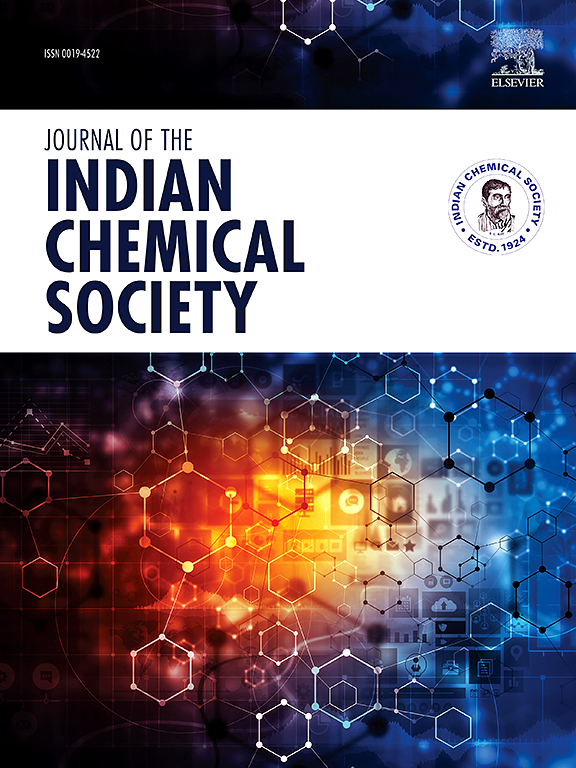多相α-NiMoO4和Fe0·2Ni0·8MoO4纳米颗粒:合成、表征及其在甲醇电氧化中的应用
IF 3.2
4区 化学
Q2 CHEMISTRY, MULTIDISCIPLINARY
引用次数: 0
摘要
研究了α-NiMoO4和Fe0·2Ni0·8MoO4作为甲醇电氧化非均相催化剂的合成和晶体结构。以聚乙烯醇为表面活性剂,采用溶胶-凝胶-水热法制备催化剂。表征技术包括x射线衍射(XRD)、ATR-FT-IR光谱、场发射扫描电镜(FESEM)、x射线光电子能谱(XPS)、能量色散x射线能谱(EDS)、brunauer - emmet - teller (BET)分析和热动力学TGA分析。XRD结果证实了α-NiMoO4的纯单斜晶型结构。ATR-FT-IR光谱在950和927 cm−1处显示了明显的畸变MoO6八面体单元特征,证实了α-NiMoO4的形成。FESEM图像显示泡沫状颗粒形态。Fe0.2Ni0.8MoO4比α-NiMoO4 (70.01 m2/g, 0.113 cm3/g)具有更大的表面积(163.1 m2/g)和孔隙体积(0.250 cm3/g),具有更高的织构性能。XPS分析表明,Fe0·2Ni0·8MoO4的氧空位增加,Mo6+和Mo5+态共存,从而增强了Fe0·2Ni0·8MoO4的电子结构和氧化还原性能,表明其催化电位提高。热力学和动力学研究表明活化能(Ea)、残余有机组分、八面体位配位和活化自由能(ΔG∗)之间存在显著的关系。分析了柠檬酸/聚乙烯醇部分去除对甲醇电氧化速率的影响。循环伏安法、线性扫描伏安法和计时伏安法测试表明,Fe0·2Ni0·8MoO4电极比α-NiMoO4电极具有更高的电流密度,表明其催化性能增强。本文章由计算机程序翻译,如有差异,请以英文原文为准。

Multiple phase α-NiMoO4 and Fe0·2Ni0·8MoO4 nanoparticles: Synthesis, characterization, and application in methanol electro-oxidation
The synthesis and crystal structure of α-NiMoO4, and Fe0·2Ni0·8MoO4 have been investigated as favorable heterogeneous catalysts for methanol electro-oxidation. The catalysts were synthesized using sol-gel-hydrothermal technology with polyvinyl alcohol as a surfactant. Characterization techniques including X-ray diffraction (XRD), ATR-FT-IR spectroscopy, field emission scanning electron microscopy (FESEM), X-ray photoelectron spectroscopy (XPS), energy dispersive X-ray spectroscopy (EDS), Brunauer–Emmett–Teller (BET) analysis, and thermo-kinetic analysis via TGA were employed. XRD results confirmed the pure monoclinic crystal structure of α-NiMoO4. ATR-FT-IR spectra revealed distinctive bands characteristic of distorted MoO6 octahedral units at 950 and 927 cm−1, confirming α-NiMoO4 formation. FESEM images displayed foamy-like particle morphologies. Fe0.2Ni0.8MoO4 exhibited higher textural properties with a larger surface area (163.1 m2/g) and pore volume (0.250 cm3/g) compared to α-NiMoO4 (70.01 m2/g, 0.113 cm3/g). XPS analysis of Fe0·2Ni0·8MoO4 showed increased oxygen vacancies and the coexistence of Mo6+ and Mo5+states, which enhance its electronic structure and redox properties, indicating improved catalytic potential. Thermal and kinetic studies revealed significant relationships among activation energy (Ea), residual organic components, octahedral site coordination, and activation free energy (ΔG∗). The impact of citrate/PVA moiety elimination on methanol electro-oxidation rates was also analyzed. Cyclic voltammetry, linear sweep voltammetry, and chronoamperometry tests demonstrated that the Fe0·2Ni0·8MoO4 electrode achieved a higher current density than the α-NiMoO4 electrode, underscoring its enhanced catalytic performance.
求助全文
通过发布文献求助,成功后即可免费获取论文全文。
去求助
来源期刊
CiteScore
3.50
自引率
7.70%
发文量
492
审稿时长
3-8 weeks
期刊介绍:
The Journal of the Indian Chemical Society publishes original, fundamental, theorical, experimental research work of highest quality in all areas of chemistry, biochemistry, medicinal chemistry, electrochemistry, agrochemistry, chemical engineering and technology, food chemistry, environmental chemistry, etc.

 求助内容:
求助内容: 应助结果提醒方式:
应助结果提醒方式:


